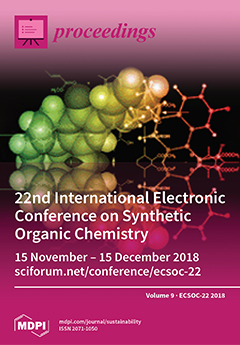Recently, considerable attention has been devoted to heterogeneous catalysts. Generally, heterogeneous catalysts offer several advantages, such as mild reaction conditions, high throughput, and ease of work-up procedures. Among the heterogeneous catalysts investigated, polymeric mesoporous graphitic carbon nitrides (g-C
3N
4) have
[...] Read more.
Recently, considerable attention has been devoted to heterogeneous catalysts. Generally, heterogeneous catalysts offer several advantages, such as mild reaction conditions, high throughput, and ease of work-up procedures. Among the heterogeneous catalysts investigated, polymeric mesoporous graphitic carbon nitrides (g-C
3N
4) have attracted much attention recently due to strong van der Waals interactions between the layers. g-C
3N
4 is chemically stable against acidic, basic, and organic solvents, and thermogravimetric analysis (TGA) also reveals that g-C
3N
4 is thermally stable even in air up to 600 °C, which can be attributed to its aromatic C-N heterocycles. More importantly, g-C
3N
4 is only composed of two earth-abundant elements: carbon and nitrogen. This not only suggests that it can be easily prepared at low cost, but also that its properties can be tuned by simple strategies without significant alteration of the overall composition. The last approach is considered to be the most efficient way to design high-performance heterogeneous catalysts utilizing g-C
3N
4 as a catalyst support. An interesting phenomenon is that the modification is mainly focused on metal oxides. Zirconia (ZrO
2) is a physically rigid material with chemical inertness. It has high resistance against attacks by acids, alkalis, oxidants, and reductants. In this study, a ZrO
2/g-C
3N
4 hybrid nanocomposite was shown to be an excellent catalyst for the conversion of alcohols and phenols into their corresponding trimethylsilyl ethers with hexamethyldisilazane (HMDS) under solvent-free conditions and for the synthesis of α-aminophosphonates. In addition, ZrO
2/g-C
3N
4 could easily be recycled after separation from the reaction mixture without considerable loss in catalytic activity.
Full article



